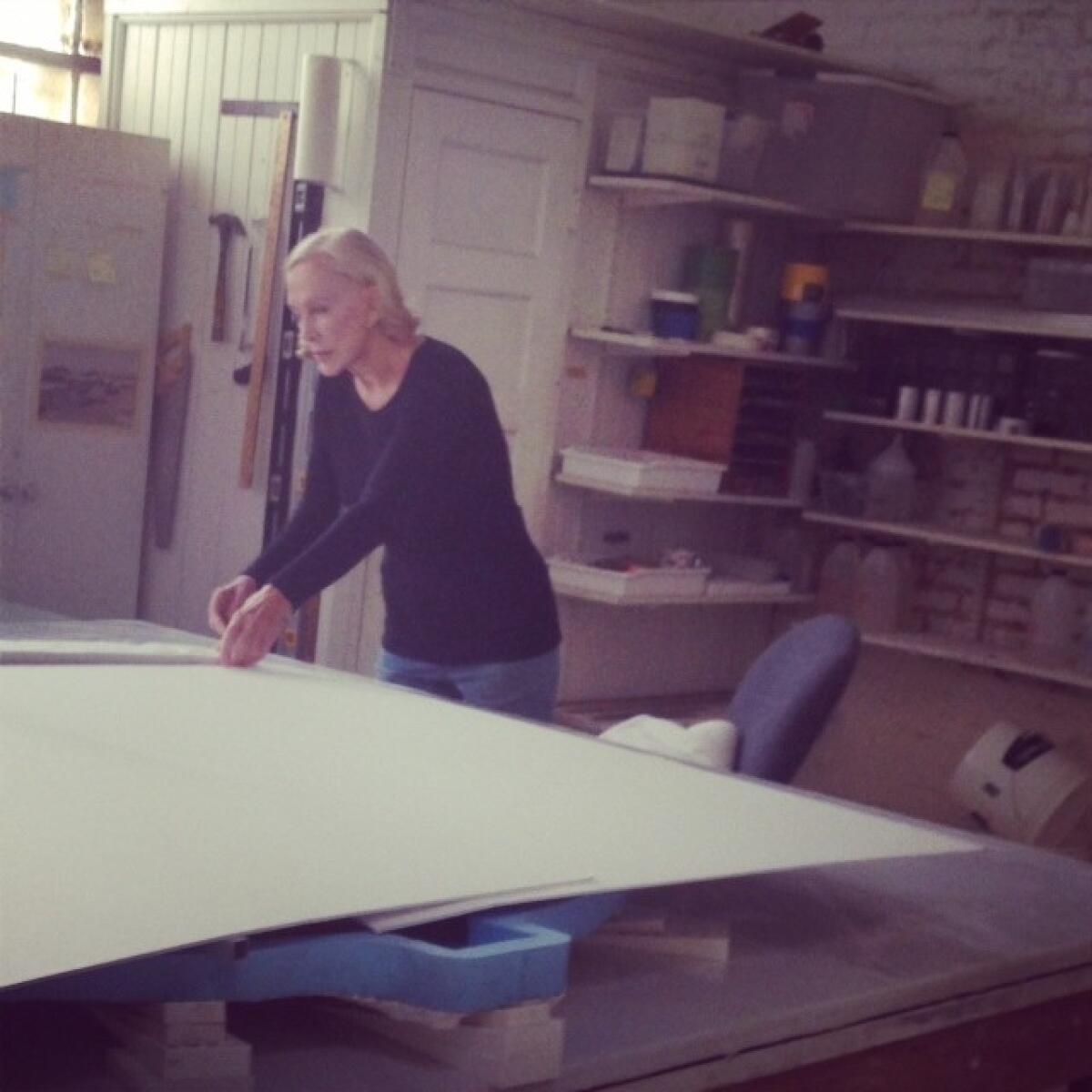Studio visit: Helen Pashgian’s ‘Light Invisible,’ bound for LACMA

- Share via
Helen Pashgian -- the 79-year-old Pasadena artist and pioneer of the California Light and Space movement of the ‘60s and ‘70s -- is finally getting a solo exhibition at a major museum. In March, the Los Angeles County Museum of Art will debut “Helen Pashgian: Light Invisible,” an installation of 12 towering and glowing two-part columns, molded from acrylic, that play with light and perception. The installation was created for the LACMA show and has not yet been seen publicly.
For a sneak peek, Pashgian invited us to her Pasadena studio, a converted piano warehouse nestled down an alleyway between a parking garage and a coffee house. On a chilly and drizzly day, Pashgian’s brick studio, painted sunny yellow and ocean blue, popped against the heavy, gray sky.
She did too, tall and athletic, opening the door with exuberance. “Come on inside!” she said brightly. “Let’s get this started!”
PHOTOS: Arts and culture in pictures by The Times
Full of energy -- she’d risen at 5 a.m. to work out with her trainer -- Pashgian raced between the four rooms of the building, explaining her creative and technical processes, as well as themes in her work.
“They’re all about mysterious elements that relate to the perception of light,” she said. “I’m interested in the depth and the light, objects floating in a space that is not defined.”
As she spoke, one of her triptychs resembling blue waves was visible in the background; rain dripped down the exterior of a picture window. The effect was oddly and appropriately aquatic.
She is addressing the space “where air meets the water,” she said, referring to the play of light and movement on the surface of water. “That’s what I’m most interested in -- the surface, and below the surface and below that.”
During the studio tour, Pashgian spoke of what it was like to come up with light and space artists such as James Turrell, Peter Alexander, DeWain Valentine and Larry Bell -- and to be one of a few women working in that form at the time.
She spoke of her years in Boston, a critical period when she transitioned from being an art historian to a creator of art.
PHOTOS: Best art moments of 2013 | Christopher Knight
She crawled atop her worktable and demonstrated how to cast a sculptural mold, swinging her legs over a chair like a gymnast. All the while, the narrative continued. She spoke of what drew her back to Los Angeles from Boston: “the light,” she said.
“It was always gray,” she said. “When I first moved to Boston in the fall ... the sun didn’t come out for a month. I didn’t realize how depressed I’d gotten by the dark. I finally realized I needed to come home.”
Inside the dim inner-sanctum of her studio, Pashgian was calm and focused, seemingly grounded by the 8-foot-high, luminescent columns created for LACMA. One of them looked as if it housed a floating jellyfish-like disc; another seemed entirely empty but for small pin pricks of light. Collectively, they looked elegant and austere, mysterious and dramatic. What appear to be simple, vertical tubes housing geometric projections actually contain an elaborate architectural infrastructure -- “clamps and glues and things. You can’t see that, but it’s very complex,” Pashgian said.
PHOTOS: Faces to watch 2014 | Art
The installation, which will be configured as a 120-foot row in the museum’s Art of the Americas Building, is something of a departure for Pashgian. Her work, she said, typically features color -- deep ocean blues or warm clay reds -- and is often meant to hang on the wall, where the lighting elements can be carefully positioned. The way light interacts with her sculptures, bringing them to life, is integral to the work.
This newest body of work, which Pashgian mulled for about 10 years, she said, is vertical and free-standing. The lighting is still carefully controlled from above, but visitors can walk around the sculptures, which change when viewed from different angles.
Two of Pashgian’s sculptures are on view at Ace Gallery on Wilshire Boulevard in Beverly Hills. They will be up for about a month. “Helen Pashgian: Light Invisible” opens at LACMA on March 30.
ALSO:
Valley Performing Arts names new directorBroad Museum reveals plans for landscaped plaza
An appropriate time for appropriation art at the Hammer
Twitter.com/@debvankin
More to Read
The biggest entertainment stories
Get our big stories about Hollywood, film, television, music, arts, culture and more right in your inbox as soon as they publish.
You may occasionally receive promotional content from the Los Angeles Times.











